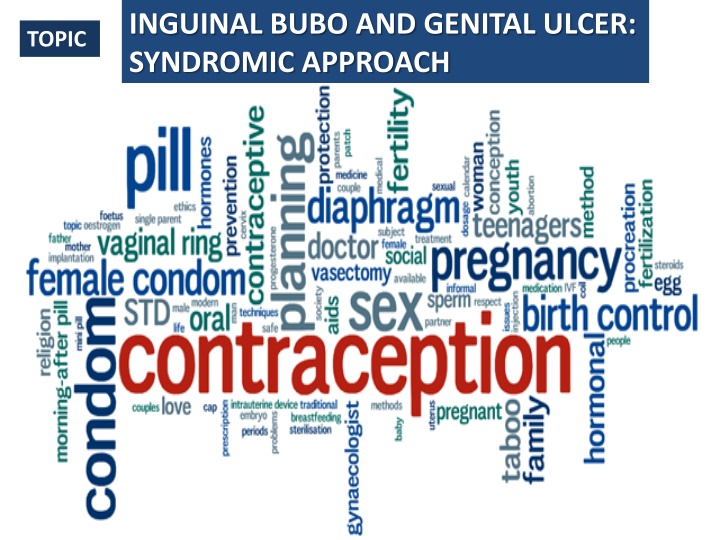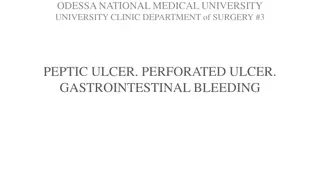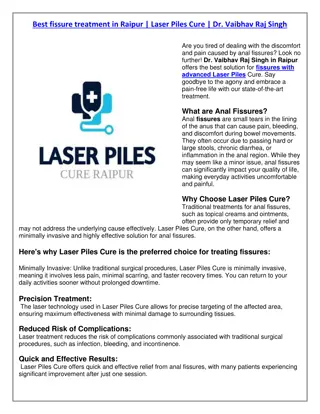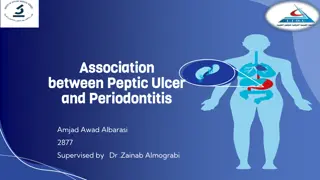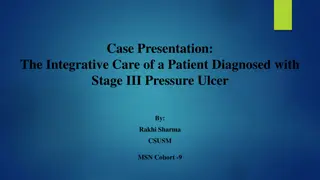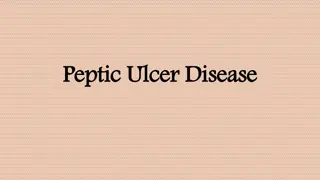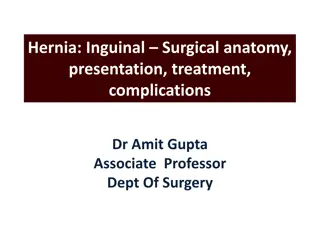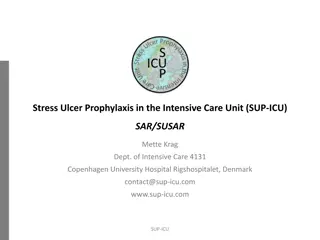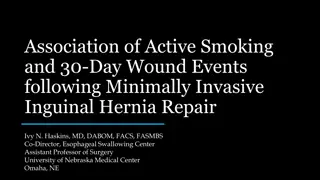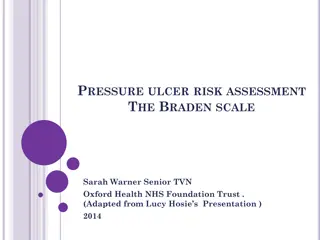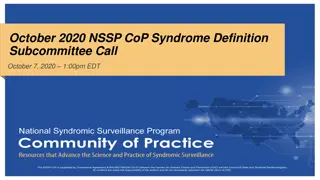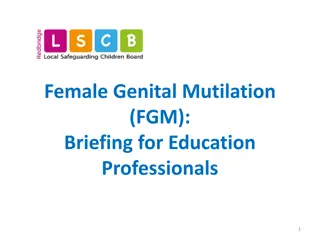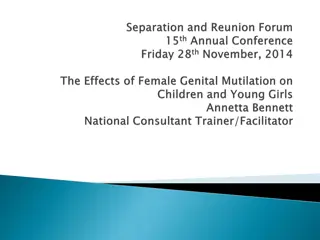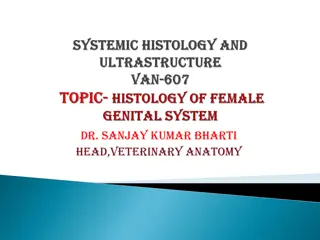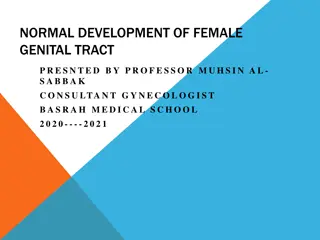Inguinal Bubo and Genital Ulcer: Syndromic Approach by Dr. Rohit Kumar Singh
This informative content discusses the syndromic approach to managing inguinal bubo, genital ulcers, urethral discharge, scrotal swelling, vaginal discharge, lower abdominal pain, and neonatal conjunctivitis. It includes recommended treatment regimens for lower abdominal pain and emphasizes the importance of proper diagnosis and treatment protocols for various genital and neonatal issues.
Download Presentation

Please find below an Image/Link to download the presentation.
The content on the website is provided AS IS for your information and personal use only. It may not be sold, licensed, or shared on other websites without obtaining consent from the author.If you encounter any issues during the download, it is possible that the publisher has removed the file from their server.
You are allowed to download the files provided on this website for personal or commercial use, subject to the condition that they are used lawfully. All files are the property of their respective owners.
The content on the website is provided AS IS for your information and personal use only. It may not be sold, licensed, or shared on other websites without obtaining consent from the author.
E N D
Presentation Transcript
INGUINAL BUBO AND GENITAL ULCER: SYNDROMIC APPROACH TOPIC Dr. Rohit Kumar Singh Resident, MD Dermatology Base Hospital
LOWER ABDOMINAL PAIN Recommended syndromic treatment 1. ceftriaxone, 250mg by intramuscular injection, once daily PLUS doxycycline, 100mg orally or by intravenous injection, twice daily, or tetracycline, 500mg orally 4 times daily PLUS metronidazole, 400-500mg orally or by intravenous injection, twice daily, or chloramphenicol, 500mg orally or by intravenous injection, 4 times daily. 2. clindamycin, 900mg by intravenous injection, every 8 hours PLUS gentamicin, 1.5 mg/kg by intravenous injection every 8 hours. 3. ciprofloxacin, 500mg orally, twice daily, or spectinomycin 1g by intramuscular injection, 4 times daily PLUS doxycycline, 100mg orally or by intravenous injection, twice daily, or tetracycline, 500mg orally, 4 times daily PLUS metronidazole 400-500mg orally or by intravenous injection, twice daily, or chloramphenicol, 500mg orally or by intravenous injection, 4 times daily. Note For all three regimens, therapy should be continued until at least 2 days after the patient has improved and should then be followed by either doxycycline, 100mg orally, twice daily for 14 days, or tetracycline, 500mg orally, 4 times daily, for 14 days. Patients taking metronidazole should be cautioned to avoid alcohol. Tetracyclines are contraindicated in pregnancy.
NEONATAL CONJUNCTIVITIS Neonatal conjunctivitis (ophthalmia neonatorum) can lead to blindness when caused by N. gonorrhoeae. The most important sexually transmitted pathogens which cause ophthalmia neonatorum are N. gonorrhoeae and C. trachomatis. In developing countries, N. gonorrhoeae accounts for 20-75% and C. trachomatis for 15-35% of cases brought to medical attention. Other common causes are Staphylococcus aureus, Streptococcus pneumoniae, Haemophilus spp. and Pseudomonas spp. Newborn babies are generally presented because of redness and swelling of the eyelids or "sticky eyes", or because of discharge from the eye(s). As the clinical manifestations and possible complications of gonococcal and chlamydial infections are similar, In settings where it is impossible to differentiate the two infections, treatment should be provided to cover both infections. This would include single dose therapy for gonorrhoea and multiple dose therapy for chlamydia. Drug options for gonorrhoea Drug options for chlamydia Ceftriaxone Erythromycin Alternatives Alternatives Kanamycin Trimethoprim/Sulf amethoxazole Spectinomycin
INTRODUCTION The term sexually transmitted diseases (STDs) is used to refer to a variety of clinical syndromes caused by pathogens that can be acquired and transmitted through sexual activity Sexually transmitted infections (STIs) are among the most common causes of illness in the world and have far-reaching health, social and economic consequences for many countries.
STI vs STD STI Infections acquired through sexual intercourse (may be symptomatic or asymptomatic) STD Symptomatic disease acquired through sexual intercourse STI is most commonly used because it applies to both symptomatic and asymptomatic infections 14
How Symptomatic are STIs? Source: WHO HIV/AIDS/STI Initiative 15
IMPACT OF STIs Considerable morbidity High rate of complications Facilitate HIV transmission and acquisition May cause infertility Treatment can be a high financial burden May cause problems in relationships divorce, abandonment, beatings. 16
INTERACTION BETWEEN HIV AND STIs Significant interaction exists b/w HIV and STIs Affect similar populations Have a similar route of transmission The interaction is bidirectional HIV influences conventional STIs STIs influence HIV 17
INFLUENCE OF HIV INFECTION ON STIs HIV alters the clinical features of STIs Syphilis: Neurosyphilis develops more frequently and rapidly HSV: Ulcers are more severe, chronic, and possibly disseminate throughout body Response to treatment may be reduced High rates of treatment failure for neurosyphilis Complications may increase and occur more quickly 18
HOW DO STIs INCREASE HIV TRANSMISSION? Reducing physical/mechanical barriers (disruption of epithelium) Increasing HIV in genital lesions, semen or both Evoking a more infectious HIV variant Increasing the number of receptor cells or the density of receptors per cell
THREE APPROACHES TO DIAGNOSIS OF RTI / STI Clinical approach Etiological approach Syndromic approach
SYNDROMIC APPROACH Syndromic management is based on the identification of consistent groups of symptoms and easily recognized signs (syndromes), and the provision of treatment that will deal with the majority or most serious organisms responsible for producing a syndrome. WHO developed a simplified tool (a flowchart or algorithm) to guide health workers in the implementation of syndromic management.
COMPONENTS OF SYNDROMIC APPROACH Classification by Syndrome: Classifying the main causal pathogens by the syndromes they produce Use of Algorithms: Using flowcharts to guide the management of a given syndrome Treatment and Counseling: Using often more than one treatment that addresses all the pathogens with potential to cause a given syndrome Treatment of Partners: Promoting treatment of sex partners
MAIN SYNDROMES Urethral discharge Genital ulcer Scrotal swelling Vaginal discharge Lower abdominal pain Neonatal conjunctivitis Inguinal bubo
SYNDROMIC CASE MANAGEMENT ADVANTAGES: Identifies and treats by signs & symptoms Syndromes easily recognised clinically Small number of clinical syndromes Treatment given for majority of organisms Simple and cost-effective Valid, feasible, immediate treatment 24
SYNDROMIC CASE MANAGEMENT DISADVANTAGES: DISADVANTAGES: Tendency to overtreat justifiable in high prevalence settings (>20%) Decreased specificity Overuse of expensive drugs Asymptomatic cases not fully addressed even with risk assessment Management of cervical infections problematic Vaginal discharge algorithm performs poorly in low prevalence settings e.g., ANC, FP 25
Patient complaining of inguinal swelling INGUINAL BUBO SYNDROME Take history and examine Educate Counsel Offer VCT Promote and provide condoms Inguinal/femoral bubo present? No No Any other STI present Yes Use appropriate flow chart Ulcers present Yes Use genital ulcer flow chart No Treat for LGV AND CHANCROID Aspirate if fluctuant Educate on treatment compliance Counsel on risk reduction Promote and provide condoms Partner management Offer VCT if available Advise to return in 07 days Refer if no improvement 26
INGUINAL BUBO Swelling of inguinal lymph nodes as a result of STIs (or other causes) Common causes: Treponema pallidum (syphilis) Chlamydia trachomatis L1, L2,L3 (LGV) Hemophilus ducreyi (chancroid) Calymmatobacterium granulomatis (granuloma inguinale) 28
LYMPHOGRANULOMA VENEREUM Tropical or Climatic bubo Durand-Nicholas-Favre disease Lymphogranuloma inguinale Poradenitis inguinalis Strumous bubo
EPIDEMIOLOGY 6% Prevalence Rate in Clinics Endemic to India 20 - 40 yrs. Male : female = 5 :1 Urban, sexual promiscuity, low socio- economic status.
AETIOLOGY Chlamydia Serovar L1/L2/L3 Obligate intracellular, Gram negative bacillus with humans as Natural Hosts by Sexual Transmission / Perinatal infection Intracytoplasmic inclusion bodies Controls the organelles of host cells for own growth and protein synthesis Cell cycle 48 to 72 hrs
PATHOGENESIS Entry into cell as Metabolically inactive elementary body (Eb) by receptor mediated endocytosis. Conversion to Active Reticulate Bodies which multiply , condense and form Eb burst out of host cells Lymphangitis, perilymphangitis, necrosis of lymph nodes PMN stellate abscess- bubo Healing by fibrosis - esthiomene, adhesions Dissemination rare
CLINICAL FEATURES Primary stage Incubation period : 5 21 days. Single, painless, evanescent, inconspicuous Papule / vesicle / Erosion / Ulcer Male coronal sulcus, prepuce, glans, urethra Female - endocervix, post vaginal wall Oral / Rectal localization NSU BUBONULUS Lymphangitic nodules over dorsal penis Chord-like swelling Constitutional symptoms
SECONDARY INGUINAL STAGE 10 30 days after primary lesion Inflammatory swelling of Inguinal nodes in males perirectal and iliac nodes in females BUBOES Fluctuant if untreated Multilocular Suppuration (70%) Unilateral 2/3rd cases Constitutional symptoms with bubo Blue ball sign / Livid colour of overlying skin over Bubo predicts rupture Groove sign of Greenblat (20%)
SECONDARY STAGE Dissemination (Rare, hematogenous) Arthritis Ocular inflammatory disease Pneumonitis Hepatitis EN / EM / EAC
TERTIARY STAGE Develops in 25% of untreated GENITO-ANO-RECTAL syndrome, more common in women / MSM Clinical features Hyperplastic Ulcerative lesions Proctocolitis Bloody purulent discharge Pruritis Ani Tenessemus
TERTIARY STAGE Lymphatic tissue hyperplasia (LYMPHORROIDS / PERI-ANAL CONDYLOMAS) Chronic Ulceration / Scarring Fistulae / Strictures (Urethral syndrome) Saxophone penis Esthiomene Mechanisms Anal Intercourse Posterior Urethral spread Direct Spread from Vaginal Secretions Lymphatic Dissemination by Cx
COMPLICATIONS Ca rectum (2-5%) Epididymo-orchitis Prostatitis Seminal vesiculitis Malignant change in esthiomene
EXTRAGENITAL MANIFESTATIONS Ocular manifestations Can occur at any stage Common with L2 Conjunctivitis, Episcleritis, Keratitis, Iritis Submaxillary, post auricular LN Cutaneous manifestations Id eruptions (photodermatitis) Ilio-Psoas Abscess
INVESTIGATIONS Microscopy / Identification Gram stain, Giemsa stain, Warthin Starry, Machiavello Isolation Culture on McCoy / HeLa Cell Line (Brown Inclusion bodies) Histopathology Stellate Abscesses / PMNs granulomatous reaction Serological tests: CFT, PCR, NAAT, immunofluorescence CT / MRI, Lymphography Skin (Frei) test
TREATMENT OF LGV Recommended syndromic treatment Doxycycline, 100 mg orally, twice daily for 21 days OR Erythromycin, 500 mg orally, four times daily for 21 days
GENITAL ULCER SYNDROME Patient complains of genital ulcer Patient complains of genital ulcer Take history & examine Take history & examine Vesicles or recurrence Vesicles or recurrence Yes Yes OR PAINFL OR PAINLESS LN +/- Educate Promote and provide condoms Educate Promote and provide condoms Offer VCT Offer VCT No No No No Treat for HSV, Treat for HSV, Ulcers and sores Ulcers and sores Treat for syphilis if indicated Treat for syphilis if indicated Yes Yes Educate and counsel Promote and provide condoms Offer VCT Ask the patient to return in 7 days Ask the patient to return in 7 days Educate and counsel Promote and provide condoms Offer VCT Treat for syphilis, chancroid and HSV chancroid and HSV DO VDRL OR RPR Treat for syphilis, No No No No Ulcers healed Ulcers healed Refer Refer Ulcers improving Ulcers improving Yes Yes Yes Yes Educate and counsel Promote and provide condoms Offer VCT Educate and counsel Promote and provide condoms Offer VCT Partner management Partner management Continue treatment for further 07 days Continue treatment for further 07 days 42
CHANCROID SOFT CHANCRE Haemophilus ducreyi Small coccobacillus Gram negative IP 3 5 days
CHANCROID PRESENTATION Genital ulcers Often Multiple, saucer shaped ulcers with erythematous halo With Sharply Defined, undermined edges Painful Non - indurated Exudative Base Bleed When traumatized (grey membrane) Inguinal lymph nodes Tender Unilateral (> ) Unilocular abscess ( BUBO) Suppurative Drain spontaneously with single sinus formation
CLINICAL VARIANTS 1. Giant 2. Dwarf 3. Large serpiginous ulcer(ulcus molle serpiginous) 4. Pagedaemic ( ulcus molle gangrenosum) 5. Transient ( ulcus molle volant) 6. Follicular 7. Pseudo grranuloma inguinale 8. Mixed 9. Chancroidal chancroid
COMPLICATIONS Painful adenitis Abscess and fistula inguinal Kissing ulcer extragenital spread Esophageal lesion in HIV pt Acute conjunctivitis Bacterial superinfection Scarring leads to phimosis Erythema nodosum / EM Enhance HIV transmission ( 3- 10 fold increase)
CHANCROID DIAGNOSIS Smear examination Gram, Giemsa and Wright s stains Rail track appearance Culture Own clotted blood, fetal calves Shoals of fish Serology CFT Skin test ( Ito-Reenstierna reaction) Biopsy is seldom helpful
CHANCROID TREATMENT Recommended regimen Ciprofloxacin, 500 mg orally, twice daily for 3 days OR Erythromycin base, 500 mg orally, 4 times daily for 7 days OR Azithromycin, 1 g orally, as a single dose Alternative regimen Ceftriaxone, 250 mg by intramuscular injection, as a single dose
GRANULOMA INGUINALE DONOVANOSIS 1st described by McLeod(1882) in Madras, India. Etiology Klebsiella granulomatis Pleomorphic, Gram negative rod Safety pin appearance 99% phylogenetic homology with K. pneumoniae Difficult to grow in culture
